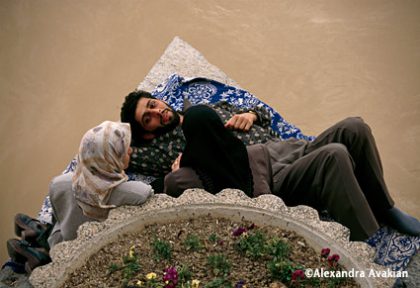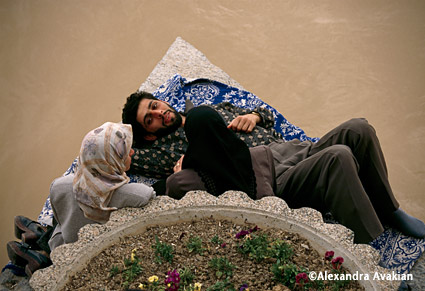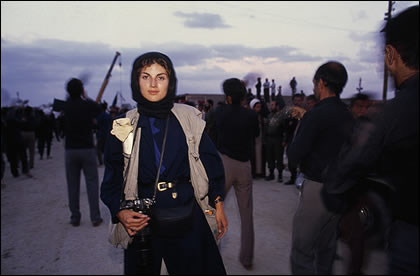
 By Alexandra Avakian
By Alexandra Avakian
Traveling in the Islamic Republic of Iran was one of my most personal journeys and is in the second chapter of my book. You probably want to know: why would an American woman with all the freedom in the world want to subject herself to so much time in the Islamic Republic of Iran, a country that has shared mutual official enmity with the United States for thirty years? Why would she go to a place where it is illegal to go outside without wearing Islamic dress and where a U.S. journalist must work with a government approved minder and have permission for every story point she wants to cover?
Deep reasons
My grandfather Mesrop Avakian was born in Iran. He came to the United States in 1923. But my family roots there stretch back to the distant past when northwestern Iran was part of the vast land of ancient Urartu. I strongly believe in crossing cultural boundaries to visually describe the lives of others, even when politics divide our countries. Indeed I have lived my life that way.
Long before I had the opportunity to go there myself, my father Aram Avakian, the film director and editor, went to scout locations in Iran for a movie he was slated to make with Sean Connery. That was in the Shah's time, the summer of 1978. He came back after a month and told me: “That was a great trip but I'll never be able to make this movie.” But why? I asked him. “There's going to be a revolution and this man will come back and take power.” He showed me underground fliers and a button with a picture of Ayatollah Khomeini on it, which he was given by his driver. He'd seen demonstrations in the street. I still have the beautiful black and white photos he took on that journey.
The first chance I got to go to the Islamic Republic myself was when Ayatollah Khomeini died. I had been covering the Arab Summit in May 1989 for Time magazine when I read that Ayatollah Khomeini had died. I quickly went to Iran and covered the grieving for him, again for Time. Then the authorities allowed me to stay on and work for almost two precious weeks.
Much of the Iranian side of my family had left by 1979. But the ones who remained, I was forbidden to see by my family in New York–an American photojournalist dropping in at that time might have brought them unwanted attention from the government. Especially since after the revolution, their building in the Tehran Bazaar had been confiscated. It took them about 15 years to prove in the Islamic courts that they had no links to the Shah's regime–when they succeeded the building was returned.
Still it was a thrill to be there, to look on the same mountains my grandfather had seen, to absorb the unique beauty of Iran. It wasn't without challenging experiences–I was pressured by my minder when he took a liking to me and was screamed at by a crowd when the sleeve of my Islamic robe (chador) slipped back to reveal my wrist. To visit friends I had to take several taxis to throw informants off our scent, so I wouldn't put Iranian friends in danger simply by visiting for a party or a meal.
But after leaving I always dreamed of going back and working in more depth. This chance came in 1998 when President Mohammed Khatami was in power and my proposal for big feature was accepted by National Geographic magazine. I spent four months in the country, given spectacular access for an American photojournalist. Khatami had launched his “Dialogue of Civilizations” outreach and had invited Western academics and journalists to come see the country for themselves, and I jumped on it. He was liberalizing some rules and aspects of Iranian society. He was liberalizing some rules AND aspects of Iranian society. I traveled almost everywhere I wanted in the country. Still, some Iranians told me that I enjoyed more freedom in their own country then they do. I joined Khatami on a three-day trip to Kordestan Province. When it was finished, the story fulfilled my desire to go beyond the headlines and the obstacles between Americans and Iranians, and to bring images from deep inside Iran to Westerners and Asians through National Geographic's domestic and various foreign editions. (You can learn more in the July 1999 cover story of National Geographic magazine, and see National Geographic Explorer TV documentary on Avakian's work “Iran: Behind the Veil”).
Every minute was precious to me, especially photographing the lives of ordinary people, political leaders, an Ayatollah, nomads, mystics, terrific women, and visiting my ancestral village in the northwest. I cover these stories in depth in my book Windows of the Soul: My Journeys in the Muslim World. There were frustrating experiences in Iran, like being detained and questioned by authorities twice or being smeared by a right wing Iranian newspaper, but nothing could spoil those memorable journeys for me. Today, Iran is again under extreme conservative rule. Yet I have been welcomed back. Until next time…
Source: Windows of the Soul blog, 29 January 2009
http://blogs.nationalgeographic.com/blogs/photography/windowsofthesoul/2009/01/iran.html
More about Alexandra Avakian
 Photographer
Photographer
Alexandra Avakian was born in New York City and grew up in her parents' world of theater and moviemaking, primarily in New York and Malibu. In 1983 Avakian graduated from Sarah Lawrence College with a B.A. in liberal arts. She also studied at the International Center of Photography and the New School. She has been a photojournalist since 1984.
Avakian has been a National Geographic photographer since 1995. Her assignments have included a cover story on Iran; photographic essays on Gaza, Romania, and Armenia; and intensive photographic projects on Lebanon's Hezbollah and American Muslims.
Her work in Iran was chronicled in an episode of the National Geographic television show Explorer. Her photos have also been published in many National Geographic books, including Women Photographers at National Geographic, Through the Lens, Wide Angle, and The World of Islam. She has also produced three books for Clarkson Potter and has been published in several Time Life books.
Avakian's exclusive coverage of Lebanon's Hezbollah appeared as a portfolio in 2006 in Time and Corriere della Sera magazine. It was also published by Der Speigel, and nationalgeographic.com and was featured on an episode of CNN's Anderson Cooper 360 news program. Her in-depth study of Muslims in America was published as a portfolio in U.S. News & World Report's special “Secrets of Islam” issue and Saudi Aramco World magazine in 2005.
She was a top freelancer for Time and the New York Times Magazine between 1988 and 1996. Between 1988 and 1992, Avakian covered the Soviet Union and its fall, including several civil wars, uprisings, and the 1991 coup. Avakian also covered the First Palestinian Intifada for seven years and many other stories in the Middle East, Africa, Eastern Europe and the Caribbean. She spent seven months covering the uprising in Haiti and documented the civil war and famine in Somalia and Sudan. Her subjects have also included the 1988 earthquake in Armenia, the funeral of Iran's Ayatollah Khomenei in 1989, and Czechoslovakia's “Velvet Revolution.”
Avakian lived in Moscow from 1990 to 1992, Somalia for six months in 1992 and 1993, and Gaza from 1993 to 1995.
Avakian has been published by the majority of mainstream news magazines in the U.S. and Europe since 1984 and has exhibited widely. She has twice exhibited solo at Visa Pour L'Image in France. In 2006 she took part in the 30th anniversary Contact Press Images exhibitions at Visa Pour L'Image and at the Pingyao International Photography Festival in China.
Avakian has been a senior member of Contact Press Images since 1991. She lives with her husband and son in the Washington, D.C., area and recently released her own book, Windows of the Soul: My Journeys in the Muslim World, published by National Geographic. She is also currently working on a book of her father's photographs of great jazz musicians.
Windows of the Soul: My Journeys in the Muslim World (a book by Alexandra Avakian)
She lived and worked for two years in the Gaza strip, often in Islamic dress, once beaten bloody by Hamas. For several terrifying days in Somalia she was pinned down by sniper fire on the way to her hotel. She careened across the snowy Tien-Shen Mountains with Islamic fundamentalists in an ancient Lada, only to be detained and tossed out by the Uzbek KGB. All the while, she captured some of the most important stories of our time?the famine in Sudan, the violence in Gaza and Somalia, the daily life of Hezbollah. She traveled extensively with Yasser Arafat as one of the only non-Arab photographers given such access. She studied her Armenian roots in Iran and the Muslim culture in America.
Recounted in gripping words and unforgettable images, Avakian's remarkable experiences will draw readers into the Muslim world to meet friends and terrorists, leaders and thieves and everyday people. Her style is always probing, yet compassionate. Given the interest in Muslim culture since the events of 9/11, Avakian's fascinating photographs and rich personal story will captivate, educate, and linger with us forever.
Source: http://shop.nationalgeographic.com/jump.jsp?itemID=4453&itemType=PRODUCT
Blog: Windows of the Soul
http://blogs.nationalgeographic.com/blogs/photography/windowsofthesoul/
Photo: South of Tehran, Iran | June 1989 | Alexandra Avakian at the temporary grave of Ayatollah Khomeini in Beheshti Zahra cemetery as men pass, beating themselves with chains in mourning. Photograph by Alexandra Avakian.
